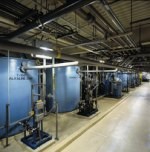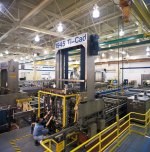Boeing's Better Work Environment
Company's new processing center grew out of the changing work environment at Boeing's Portland, Oregon, facility...
Even though Gwen Reid has multiple sclerosis and consequently limited mobility, she processes hundreds of flap support details and gears for Boeing in Portland, Oregon, every day. She is a valuable Boeing employee who knows the procedures, processes and specifications for processing flap supports and gears for all Boeing aircraft. Because of this, Brad Johnson and Neil Cernitz made sure that when the new processing shop was designed, her ergonomic needs as well as those of all the employees were considered.
"We automated the new system for two reasons," explained Mr. Cernitz, "quality and worker safety." Boeing did not want its workers needlessly exposed to processing chemicals. Also, to eliminate the recurrent injuries associated with bending and lifting, workstations were made adjustable to the height and work envelope of each employee.
The original conceptual design did not address all of the worker safety, waste abatement and automation issues that were paramount to the team. Mr. Cernitz and Mr. Johnson knew that this would not work if Boeing was to increase production and efficiency. Many changes were suggested to the plan. Eventually the original plan failed to serve as a good foundation for the project. With the assistance of those running the processing shop and the Methods Organization, a new plan was developed. This was a deviation from most of Boeing's construction projects where the facility's department and production management would oversee all phases of the program. Usually, end user personnel would have little involvement with the program until startup.
Boeing Flap Support Business Team leader Phil Cavin named Neil Cernitz to manage manufacturing requirements in the conceptual, design, and construction phases of the program. Mr. Cernitz in turn chose Brad Johnson from the shop to help convey the shop's needs and requirements and to insure that the shop would produce an end product that met Boeing specifications. They, along with selected plating operators, industriously developed a system to meet the needs of Boeing Corporation and its employees.
After a long and thorough bidding process, the new team chose Haden Management as its prime contractor. It was notable that this was one of the first times a vendor for such a BOEING PLATING shop with the cadmium/titanium plating line in foreground.
project was chosen for its proven track record and commitment to customer satisfaction rather than because it was low bidder. "Many of the innovations in our shop were due to our relationship with Haden and its representatives" Brad Johnson stated. "Working with Charlie Johnson and the other professionals from Haden Management, enabled us to take our thoughts and dreams and turn them into a `state-of- the-art' processing shop that we could be proud of."
The new shop consists of processing and painting departments. The processing shop features five fully automated processing lines. These lines are tied together through a computer network to a mother terminal that acts as an overseer for programming purposes. Neil and Brad took information and suggestions from fellow employees and drove the design of the software system. "We wanted to make sure we had a system that conformed to our specifications and was user friendly," noted Mr. Johnson.
Each line was designed with safety and waste abatement as the highest concerns. During design, the team went tank by tank through the design to ensure that all of the shop's specifications were met.
Each line has a random load scheduler that uses reservation-based methodology. Each recipe for the line is based on Boeing specifications that govern the process. The recipes for each part or process are modified with input from the line operators. Modifications are usually on the rinse, dwell and drying times. "We wanted to get rid of waste in the production stream. That is the philosophy we used when we designed the job," stated Mr. Cernitz. "On a good day, 85% of your work flow time is parts sitting in queue, traveling or set up, not actually in the processing tanks," he explained.
The recipes are then "bought off" by the shop and processed to quality control for approval. This was another major step for Boeing Portland, insuring the quality of the end-product by ensuring that the parts were processed using Boeing specifications before the parts even entered the processing lines. The shop knows that it is one way of working toward the achievement of reliable methods that will lead to defect-free quality and reduced inspection.
Each load run through the shop is traceable by shop order number, which is kept on magnetic file. This allows quality control to access information about each load at any time during processing. The information will include time in tank, temperature, voltage and amperage, ramp ups and dwell times as well as other information.
The first of the five lines, Line 1941, is primarily for processing aluminum. It does have some ferrous metal finishing capabilities. The line handles multiple and variable part loads. The sequence is aqueous clean, alkaline clean, clean and etch for Penetrant inspection, boric sulfuric acid anodize with or without seal and Alodine. Penetrant inspection tests aluminum parts for cracks and voids in the metal. After parts are cleaned and etched to remove dirt and oil, a dye penetrant is put on the parts. The parts are placed under a black light where cracks and voids illuminate.
The second processing line is 1942. This line is used for passivation of stainless steel and Nital etch inspections of machine ground parts. Nital etch checks hard steel for burns or overheating. In the acidic Nital etch process, anything that has been overheated or burned during machining shows up as a black smut. If the part fails this test, it is dissected and further tests are run.
The third line, 1943, is hard chrome plat-ing. This line has three chrome tanks with the capability of producing three finishes: hard chromium; thin dense chromium; and a decorative matte chromium finish.
Line 1944 is the fourth line in the processing shop. It is set up for sulfamate nickel plating with expansion capabilities for new processing. Currently the shop is looking at tin/zinc and zinc/nickel as possible replacements for bright cadmium plating. The challenge is not just finding an "off-the-shelf" substitute. Boeing rigorously tests all baths and works with suppliers to develop systems that meet its specifications.
The last line, 1945 is dedicated to cadmium/titanium alloy plating. The line has two cadmium/titanium alloy plating tanks with all the supporting process tanks. "One of the largest challenges was producing a reliable method for cadmium/titanium plating that would provide 100% coating thickness within 0.0002 inch as required by Boeing specification," stated Mr. Johnson. "With the use of automation, precise chemistry Armor Clad® racking (by Mitchell-Bate Co.) and experienced workers, we believe we have met our expectations in this area."
Two ovens provide hydrogen relief baking after plating. The finishing facility also features a paint shop that boasts the largest open front Class 2 oven in the company. The semi-automated shop was designed with help from Boeing paint shop personnel. It incorporates Boeing designs in almost all aspects of the shop. Shop capabilities include: epoxy powder coat; plastic media blasting; automated ink jet part numbering: epoxy coating; polyurethane coating; masking; flash-off oven and curing oven.
Now Boeing Portland has a first-class finishing department that meets Boeing specifications. But, more importantly, it meets the needs and "specifications" of its employees and meets the changing work environment at Boeing Corporation.
Related Content
10 Anodizing Best Practices
Following this list of guidelines can help to increase the performance, cost effectiveness and quality for your anodizing operation.
Read MoreChicago-Based Anodizer Doubles Capacity, Enhancing Technology
Chicago Anodizing Company recently completed a major renovation, increasing its capacity for hardcoat anodizing and Type II anodizing.
Read MoreNADCAP Shop Digitizes to Eliminate Paper Trail
Customizable ERP software has transformed a 27-year-old manual metal finishing job shop into a state-of-the-art paperless company with full digital traceability in about 10 months.
Read MorePlating, Anodizing Equipment for Variety of Applications
Titan Metal Fabricators Titan Metal Fabricators, Rightech Fabrications and Optimum Anode Technologies are leading suppliers of equipment for the plating and anodizing industries.
Read MoreRead Next
A ‘Clean’ Agenda Offers Unique Presentations in Chicago
The 2024 Parts Cleaning Conference, co-located with the International Manufacturing Technology Show, includes presentations by several speakers who are new to the conference and topics that have not been covered in past editions of this event.
Read MoreDelivering Increased Benefits to Greenhouse Films
Baystar's Borstar technology is helping customers deliver better, more reliable production methods to greenhouse agriculture.
Read MoreEducation Bringing Cleaning to Machining
Debuting new speakers and cleaning technology content during this half-day workshop co-located with IMTS 2024.
Read More















.jpg;maxWidth=300;quality=90)








